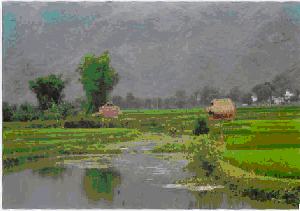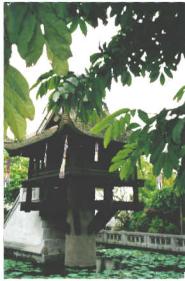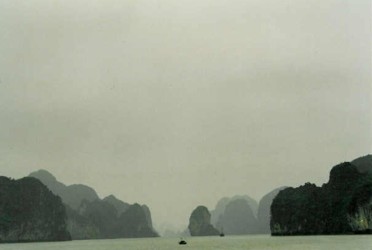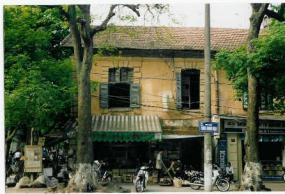|
Jeffrey Tao's Travel
Impressions
Hanoi
- Intriguing Mixture In 1997, at the tail-end of a tour of Cambodia, I had briefly visited Ho Chi Minh City (Saigon), Vietnam’s great southern metropolis, and was impressed by the hard-edged commercial culture and raw energy of the city, pulsating with life and unceasing movement. That glancing acquaintance with Saigon whetted my appetite, and I vowed to return, but it was not until April 2001 that I had a chance to come to this country again. This time I chose Hanoi. Differing
Perceptions
Hanoi is a city which has elicited radically different reactions from visitors. There are those who would gladly shun the noise and chaotic traffic of Saigon in favor of the quiet, tree-lined neighborhoods of Hanoi. Others found the Vietnamese capital too austere and somewhat drab in comparison with the flamboyance of Saigon, and some even wrote it off as being emblematic of a Communist country, with little else to offer. This did mean, however, that I arrived here with a completely open mind, and very much more curious about the city than I would have been normally. Of course, Hanoi was already beckoning as soon as I boarded my Vietnam Airlines flight in Bangkok, with stewardesses gliding gracefully like swans up and down the aisle dressed in their cream and maroon “ao-dais,” the Vietnamese national costume, which is a most flattering combination of trousers and a form-fitting, high-collared tunic slit at the waist. The allure generated by the ao-dai, however, was not matched by the kind of feminine charm that a visitor might associate with those wearing it. It was obvious that the concept of “Service with a Smile “was still new to them. There was a stiffness and slight haughtiness of mien about these stewardesses that contrasted sharply with the easy and pleasant graciousness of their Thai counterparts. Upon arrival, I was shepherded through immigration and customs by a friendly young guide and driven into central Hanoi in a white Daewoo. In less than an hour we had arrived at my hotel - an attractive colonial villa in the heart of the city, an area which used to be known as “Ville Francaise.” The De Syloia bills itself as the best boutique hotel in Hanoi, and indeed, with only 33 rooms and what I soon discovered to be very warm and attentive service from its exceptionally friendly staff, this was certainly no exaggeration. It had been sweltering in Bangkok at around 38 degrees Celsius, and with the contrast of the much cooler weather here, I suddenly felt weary, and, holding back my pent-up desire to explore the neighborhood immediately, went straight to bed, completely at home in my new surroundings. Journey into the Hill CountryWe were off to an early start the next day, after a hearty breakfast which was a felicitous combination of East and West, consisting of coffee, croissant and a bowl of “pho,” Vietnamese rice noodles served in a tasty clear broth with parsley, scallions and sliced beef. Thus fortified, we sped off on a 140-kilometer trip into the hills, to visit an ethnic minority village in the district of Maichau, south-west of Hanoi. It was going to take three or four hours to reach our destination. Once we got beyond the dreary suburban areas of Hanoi, I was entranced by the scene of intensely green paddy fields, punctuated by farmers in conical hats, bent down in ceaseless toil, and knee-deep in water. In the distance, undulating blue-green hills framed the horizon. By mid-morning we had reached Hoa Binh, the capital of the province of the same name. From this point onwards, I could feel the car going uphill, and we were winding our way up Highway 6, the famous road that runs through the mountains all the way west to the Laotian border, culminating in Dien Bien Phu, where the French colonial army suffered such a major and humiliating defeat in 1954 that France put an end to her rule in Vietnam. The paddy fields began to give way to neat terraces of tea bushes. There were also banana trees, and groves of slender bamboo with their perfectly-shaped narrow leaves. Quang, who by now had realized that I was Chinese, spoke of the enormous importance China had assumed in this part of Vietnam. The border town of Lang Son, one of the gateways into China, (the famous Friendship Pass), is only 6 hours to the north-east of Hanoi by car. Trade in the border area has been growing by leaps and bounds since 1991, when the border was reopened and normal relations resumed after more than twelve years of mistrust and tension caused by several events that damaged relations: the Vietnamese invasion of Cambodia in 1978, the mass exodus of ethnic Chinese from Vietnam in 78 and 79 as a result of harsh government policies, and a 17-day war fought by ground troops in the Sino-Vietnamese border region in the Spring of 79. Quang and I were both glad and relieved that the two countries had put all of that behind them. Now Vietnam sells rice, peanuts and sugar-cane to China in return for motorcycles, electrical appliances and consumer durables. Chinese-made motorcycles, at less than half the price of Japanese ones of higher quality, are now all over the Hanoi area. White Tai VillageWe were climbing higher and higher, and one could now see houses on stilts, the homes of the Tai and Muong minorities. At one point, our car swung around the corner, and our destination lay below us - nestling in a verdant valley ringed by mountains on all sides was a cluster of villages making up the district of Maichau. Soon we were at the entrance of the village we were to visit, Ban Lac, and entered by a pathway on foot. All around us was a serene and idyllic scene. The jade-green paddy fields, crisscrossed by irrigation channels, stretched as far as the foot of the hills. Little farm huts with thatched roofs dotted the landscape. A clear, gurgling stream ran through the village, and water buffaloes lounged lazily under houses on stilts, shielded from the mid-day sun.
Women worked the loom with deft fingers, their skills inherited from their mothers and grandmothers. This was a White Tai village, where the inhabitants are distantly related to the Tais in Thailand. A few local families have opted to supplement their income from farming and weaving by opening their homes to visitors, providing food and hospitality. We were received warmly in one of the wooden houses on stilts with bamboo strips for flooring. The daughter, who spoke fluent Vietnamese and a smattering of English, served tea and chatted with the visitors, while her father prepared lunch (Tai men are well-known for their culinary skills) and her mother helped with the household chores. No doubt, the pervasive influence of tourism and commercialism has reached Ban Lac, but I thoroughly enjoyed this experience because of the graciousness and quiet dignity of the family. One had a strong sense of authenticity about this village and its people - there were no tawdry souvenirs or packets of postcards to be seen. After a copious lunch, we admired the wide array of woven textiles displayed in the village, and I was very much taken with the bold colors and animal motifs of the Dzao minority fabrics. By early afternoon, after thanking our hosts, we had started on the long drive back to Hanoi. Ho
Chi Minh’s Residence
The next two days were spent touring the major sights of Hanoi. Ho Chi Minh’s Mausoleum, Presidential Palace and Museum were at the top of the list. Revered by his compatriots as the single most important patriot, revolutionary and political leader in 20th century Vietnamese history, Ho was unquestionably the father of modern Vietnam. He founded the Indochinese Communist Party in 1930, drove the French out of Vietnam in 1954, and, after his country’s partition in the same year, directed the armed struggle to reunify the south and against United States intervention, until his death in September 1969. On the day of my visit, Vietnamese from near and far, immaculate in their best finery, some carrying bouquets of flowers, had come to pay respects to his memory and remind their children of Uncle Ho’s sacrifice and accomplishments. Tour groups from Shanghai and New York and elsewhere were waiting in line to enter these hallowed halls. Ho’s Presidential Palace, where he lived between 1954 and 1969, is an enchanting place - it was formerly the Palace of the French Governor General of Indochina, with flowers, mango trees and manicured lawns. Ho would only use the imposing palace building to receive guests and hold ceremonial functions, preferring to live in a modest green-shuttered house nearby that used to be where the electrician lived. In 1958, he moved to a simple but elegant wooden house on stilts that he had built based on a hill-tribe design, and facing a lovely pond full of colorful carp. The
One-Pillar Pagoda
The Temple of LiteratureOne of the oldest and most venerated temples in Hanoi, The Temple of Literature or Van Mieu (Wen Miao in Chinese) is a monument to learning and a bastion of privilege. It was established in 1072 by one of the Ly emperors to honor Confucius and other men of high moral and scholarly attainments. Vietnam’s first university known as Quoc Tu Giam was founded in this temple complex in 1076, and became the elite institution for educating the children of the ruling official class. Ancient Confucian texts were studied here, in preparation for adult life as models of moral rectitude and scholar-administrators, very much in the Chinese tradition. The architecture is traditional Vietnamese and said to be modeled on the Temple of Confucius in his hometown of Qufu, in China. The temple has five courtyards divided by walls and connected by pathways. Some of the courtyards have ponds in them, conducive to quiet contemplation and study. I noticed that one of the ponds was completely covered by water hyacinth, with its lilac flowers contrasting with the shimmering green of the leaves. In the third courtyard are a number of stone steles with sculptured tortoises as bases, some dating back to the 15th century, the oldest relics in the complex - most of the rest of the temple had to be rebuilt during the first half of the 20th century. Carved onto the steles are the names and dates of birth and scholastic achievements of successful doctoral candidates - considering the fact that the grueling examinations were held only once every three years, these scholars certainly richly deserved being memorialized in this way. Haiphong
Our next destination was going to be Halong Bay, and en route we stopped for lunch in Haiphong, some three hours’ drive east of Hanoi on the coast. The people of this city have had their fair share of misery. In 1946, a dispute triggered French shelling and aerial bombardment of Haiphong, leading to hundreds of civilian deaths. During the Vietnam War (which the Vietnamese call the American War), since it was the only northern port able to receive aid and relief supplies, it was ( as was Hanoi itself ) subjected to intense American naval bombardment and air strikes between 1965 and 1972. There are few signs of the ravages of war today in this quiet port city that has many lovely colonial buildings, with pastel pink being a favorite color and the Opera House downtown being perhaps the best example of that. At a square in the center, there is a large and imposing statue of a woman warrior in full battle regalia who had fought under Emperor Le Loi against the Chinese in the 15th Century - she was a native of Haiphong. True to its reputation as the City of Flower-lined Streets, a neat and attractive flower market can be found near the downtown square. In terms of Vietnamese architecture, the city can proudly point to 300-year-old Du Hang Pagoda, set in a lush garden, and still functioning as a school for monks as well as a place of worship. Halong BayIt was evening by the time we reached Halong City. My hotel was a converted French villa at the top of a hill overlooking the Bay. I was told that Ho Chi Minh himself had stayed at this illustrious guest house. My room was spacious and airy and its French windows opened onto a terrace with pine trees. From this vantage point I looked out onto the Bay, fringed with limestone formations called “karsts” which from a distance looked like strange unknown animals huddled together in a heap. Occasionally, I would hear the sound of a speed boat hurtling across the bay and piercing the quiet of the balmy spring evening. A few large ships were anchored in the azure water, standing mute and unobtrusive. A member of the staff knocked on my door and brought me a “dragon fruit.” I peeled off its thick red skin and devoured the firm, juicy flesh with relish, sitting down on one of the large chairs with antimacassars that reminded me of waiting rooms in train stations in China during the 80’s. I felt strangely elated, but wondered whether I was in some kind of a time warp, or in a place that was merely a figment of my imagination, a mosaic pieced together from fragments of what I’d seen and experienced in China, in Europe and in the tropical, exotic lands of Southeast Asia. Like
a Ming Painting
Bright and early next morning we arrived at the pier and to my dismay, ours was one of many boats moored at the marina and poised for action. A refreshing cup of hot green tea soon put me in the right frame of mind, and my spirits lifted as our boat moved away from Halong City toward the wide expanse of the Bay. Before long, we were no longer accompanied by the armada of tour boats of varying sizes. Halong Bay has thousands of islands covering a large area, all the way up to the Chinese border. The limestone landscape extends further northward into Guilin in the Chinese province of Guangxi, renowned for its scenic splendor for centuries. It was an overcast day, but the peaks of the islands formed distinct contours against the sky - a peak would look like a camel’s back with 3 humps, or an elephant without its trunk, or some other strange, incomplete creature. Sometimes two sheer cliffs would form a narrow triangular ravine, but be joined at sea level by a narrow strip of land. And then there was a delightful group of low-lying individual formations shaped like the peaked caps of the Seven Dwarfs. Of course, the subtle brush paintings of the Chinese masters of the Ming Dynasty capture the elusive quality in this kind of scenery well - layer upon layer of mountains standing in the middle of the water, the contours of the ones furthest away being the most indistinct and mist-shrouded, their colors graduating from dark green to slate blue to light gray. I stood for long periods at the front of the boat, clutching my camera, afraid of missing something. Here and there, fishing boats dotted the surface of the gently-rippling emerald waters which were only lightly dappled by the faint rays of the sun.
I had completely lost track of time when Quang said that it was already noon and we should start heading back to the harbor. While we steamed back to port, a sumptuous seafood meal was served, starting with steamed prawns and crabs, followed by fried calamari, steamed whole fish, a plateful of spring rolls and delicious fresh vegetables. This was a very civilized way of touring Halong Bay. For our drive back to Hanoi, we took a northern route by-passing Haiphong. Not surprisingly, on the way, my attention was drawn to yet another tale of military valor. At the Bach Dang river, General Tran Hung Dao, a national hero, led a cunning defense against Kublai Khan’s invading army in the 13th century by having sharp teak wood stakes implanted in the river bed when the river was flooded. When the enemies sought to cross the Bach Dang, the bulk of Kublai’s ships were impaled on the stakes, and became vulnerable to Vietnamese attack. The much-feared and invincible Mongol army which had occupied all of China was thus routed at this famous battle. Hanoi’s
diverse neighborhoods
During my city tour Quang had taken me to the warrens of the Old Quarter, where each street specialized in a particular product, say, paint, cotton, silk, or funerary paraphernalia, and would be named accordingly, reminiscent of the “hutongs” in the old sections of Beijing. The Old Quarter was bustling with activity, with seafood markets fully stocked with fresh squid, eel, crab and turtle, melons and vegetables piled high in heaps, florists doing a roaring trade, and vendors of cooked foods displaying a mouth-watering array of spring rolls at their stalls.
Only fifteen minutes’ walk away is a grand colonial institution with balconies and fluted columns, the Metropole Hotel, where Somerset Maugham stayed in 1921 during a trip through Southeast Asia. The hotel has been fully renovated, but in such a way as to preserve its old-world charm - much like the Strand in Rangoon and the Raffles in Singapore. As soon as one steps out of the elegant lobby of the Metropole, though, the realities of the developing world assail you - young children clamor to sell you postcards with a persistence surpassed only by their counterparts in Saigon, taxi drivers and men on motorcycles offer their services and won’t take no for an answer. Hanoi is a mixture not only in the cultural and architectural sense, but also in the political and economic sense. It is a capital city in transition from the pain and destruction wrought by war to sustained peace and prosperity, from planned to free markets and from isolation to openness. Hanoi has become a microcosm of the whole county - and the Vietnamese are a people in a hurry, impatient to move ahead on every front. On my last night, I had a chance to explore the Opera House and Hoan Kiem Lake, both within walking distance from the De Syloia. To reach the former, I walked along Trang Tien street which reminded me of Huai Hai Avenue in the former French Concession in Shanghai. I tarried at the many art galleries and book shops along the way. The Opera House, designed by the same architect who designed the Paris Opera, was built in 1911. Formerly used as the Municipal Theater, it was from its balcony that a committee of citizens of Hanoi declared Vietnam’s independence from France in 1946. Ironically, during a Francophone Summit held here a few years ago, President Chirac, seeing the Opera House now as a potent symbol of continuing friendship and close ties with Vietnam, announced the provision of French funds to restore the run-down building to its former glory. In the 15th century, the Emperor Le Loi sought divine help to fight the Ming armies from China. He received a sacred sword which gave him victory over the Chinese. One day, while boating on a lake, a huge gold tortoise leapt up from the waves, seized his sword and quickly disappeared into the depths of the lake again. The sword was returned or restored to the heavens through the intermediary of the tortoise. Hoan Kiem Lake or “Restored Sword Lake” derives its name from this legend which is a perennial theme in art, plays and puppet shows in Vietnam. The lake seemed to me particularly enchanting that evening, with the city’s multi-hued lights dancing on its limpid surface. Lakeside cafes and patisseries-boulangeries were catering to the needs of those out for a stroll. Seated on benches by the lake, old men were chatting with their friends, reminiscing about some battle they had fought together perhaps, young couples were locked in amorous embrace, totally oblivious of everything, and mothers were brushing the hair of their young daughters, whispering gentle admonitions in their ears meanwhile. My evening walk around this urban oasis afforded me a glimpse into Hanoi at leisure, during the more relaxed and intimate moments of the daily lives of its people. Exorcizing
the Ghosts of the Past
I was in the Hanoi area from April 22 until April 27. When I returned to New York on April 28, I found the newspapers and television full of reports and commentaries about how former Senator Bob Kerry continued to be haunted by a memory of having killed unarmed civilians in South Vietnam in 1969 during a naval commando raid. My trip had sparked my intense interest in this topic, something that I had never felt before in quite the same way. More than 25 years after it ended, the Vietnam War still occasionally moves into the center of the collective American consciousness, like a stubborn ghost that refuses to be exorcized. I am sure that the Vietnamese are also grappling with issues left over from the conflict. But then they had won that war in the same way they had won other wars they had fought with big powers in the course of their history. The courage and prowess of the Vietnamese in battle are a well-proven fact. But, judging from what I had seen and heard from my visit, it is clear that they are ready to move on, to enjoy independence in the fullest meaning of the word, and to build a more prosperous, more open and cosmopolitan country. I have no doubt that, with their natural intelligence, indefatigable drive, energy and persistence, they will succeed in peace as well as in war. In the next 10 years, Vietnam will be a country to watch, and I am eager to return to follow her progress. J.T., June 2001 |

 A
beautiful legend is associated with this unusual monument.
A
beautiful legend is associated with this unusual monument.
 But
I took great pleasure in just exploring the immediate vicinity of my hotel in
a totally unscheduled way.
But
I took great pleasure in just exploring the immediate vicinity of my hotel in
a totally unscheduled way.